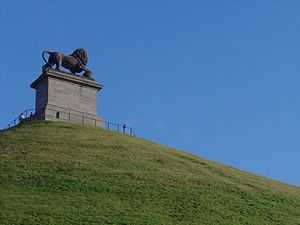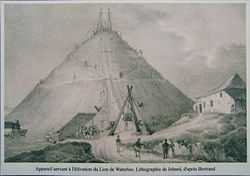Lion's Mound
Coordinates: 50°40′42″N 4°24′17″E / 50.67833°N 4.40472°E

The Lion's Mound (or "Lion's Hillock", "Butte du Lion" in French, "Leeuw van Waterloo" in Dutch) is a large conical artificial hill raised on the battlefield of Waterloo to commemorate the location where William II of the Netherlands (the Prince of Orange) was knocked from his horse by a musket ball to the shoulder during the battle. It was ordered constructed in 1820 by his father, King William I of The Netherlands, and completed in 1826. The prince fought at the preluding Battle of Quatre Bras (16 June, 1815) and the Battle of Waterloo (18 June, 1815).
The design
The monument was designed by the Royal Architect, Charles Van der Straeten, at the behest of William I. Inspiration was provided by the engineer Jean-Baptiste Vifquain, who conceived of it as a symbol of the Allied victory, rather than as pertaining to a single individual. The shape consciously recapitulates that of the tumulus of the Belgae, whom Julius Caesar had singled out as the bravest of the Gallic tribes.
The hill

A huge mound was constructed at the spot, using earth taken from other parts of the battlefield, including the fields between La Haye Sainte farm and the Duke of Wellington's sunken lane.
The mound is 43 m (141 ft) in height and has a circumference of 520 m (1706 ft), which dimensions would yield a volume in excess of 390,000 m3 (514,000 yd3), despite the usual claim of 300,000 m3. The discrepancy might be accounted for if part of the volume is occupied by an existing volume of some topographic feature, say, the ridge of Mont-St. Jean.
Victor Hugo mentions in his novel Les Miserables that on visiting the site two years after the completion of the mound, the Duke of Wellington is said to have remarked, "They have altered my field of battle!"[1] Be that as it may, the hillock offers a splendid vista of the battlefield, and is the anchor point of the tourist trade associated with it in le Hameau du Lion (Lion's Hamlet), where there are museums and taverns. A fee of €7 is charged to ascend the 226 steps leading to the statue and observation area at the top. Orientation maps documenting the battle and telescopes are provided.
The statue

The hill is surmounted by a statue of a lion mounted upon a stone-block pedestal. The model lion was sculpted by Jean-François Van Geel (1756–1830), and bears close resemblance to the 16th century Medici lions. The lion is the heraldic beast on the personal coat of arms of the monarch of The Netherlands, and symbolizes courage; its right front paw is upon a sphere, signifying global victory. The statue weighs 28 tonnes (31 tons), has a height of 4.45 m (14.6 ft) and a length of 4.5 m (14.8 ft). It was cast at the iron foundry of William Cockerill in Liège, whence it was brought by canal barge from Liège to Brussels, and thence by heavy horse-drays to its final site at Mont-St. Jean, a low ridge south of Waterloo.
There is a legend to the effect that the lion was cast from brass melted down from cannons abandoned by the French on the battlefield. The statue was, in fact, cast of iron in nine pieces, which were assembled at the monument site.
References
- ↑ Victor Hugo. Les Miserables Chapter VII. Napoleon in a Good Humor
